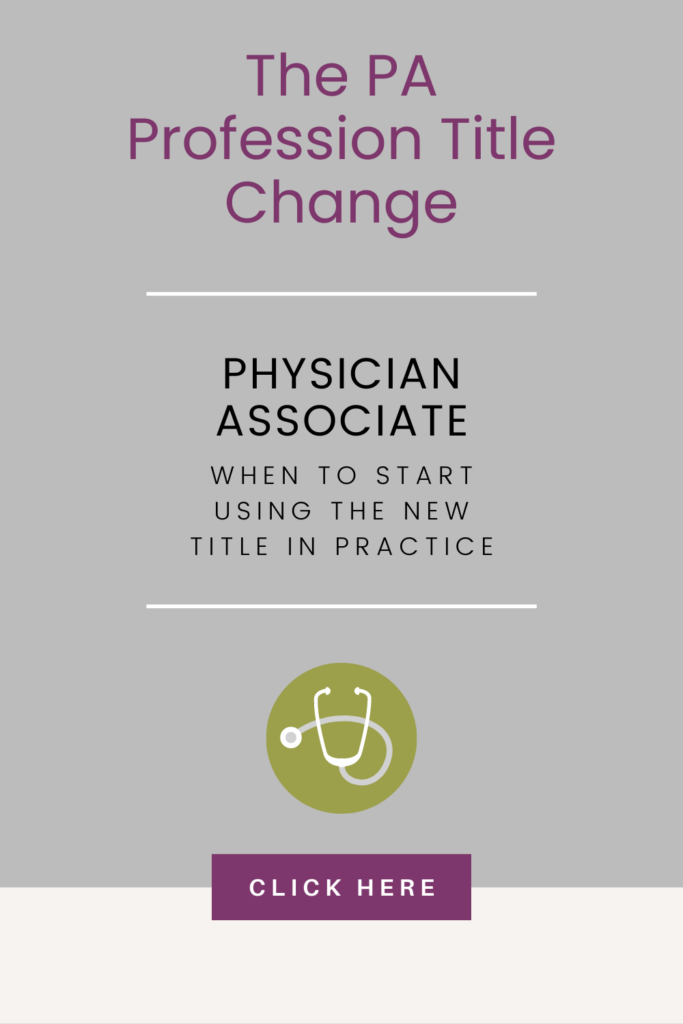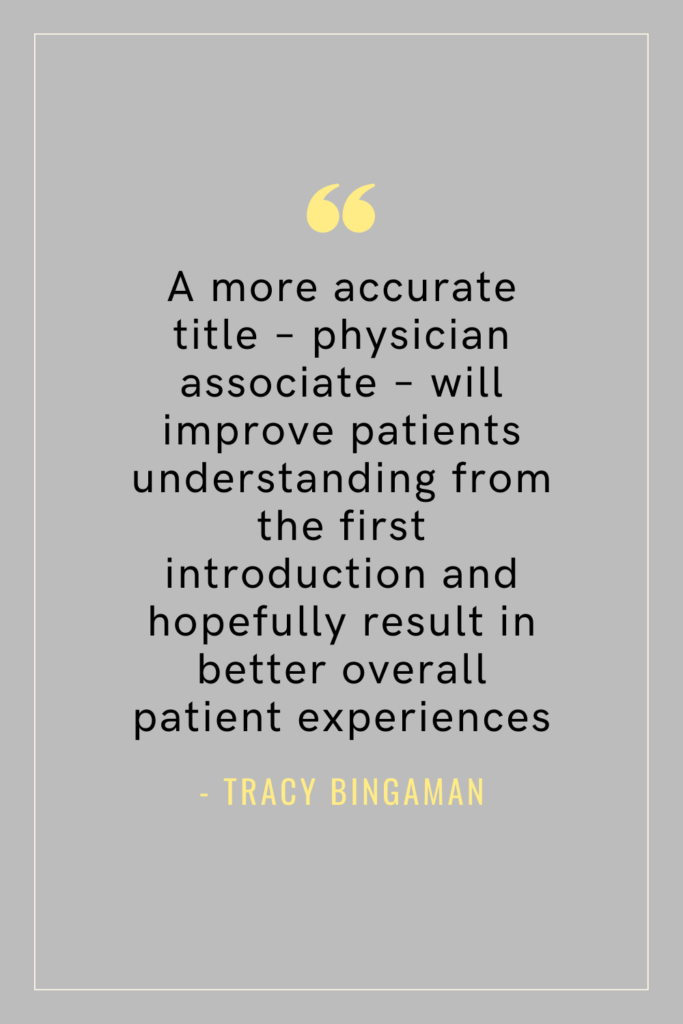As you well know and as I share in my introduction to this show, Physician Associate has taken the place of Physician Assistant as the professional title of choice. But what *exactly* does this PA profession title change mean for your practice? Should you start to use Physician Associate in everyday interactions? Why or why not?
Today we are going to unpack the Physician Associate Title Change Implementation so you can understand when it’s OK to start using Physician Associate, depending on where you live and what changes have been made in that area.
This episode is from March of 2023, using the most current information from the AAPA as the main source.
Watch on YouTube Here

APPLE PODCASTS | SPOTIFY| YOUTUBE
Current PA Title Change Status
Here’s where we are at: the current official title for the PA profession is “physician associate”.
The AAPA is now the American Academy of Physician Associates.
Current recommendations are to continue to use “PA” or “physician assistant” as your official, legal title in professional capacity, particularly within a clinical setting where you are working with or speaking to patients.
Going forward and at at the time of this recording, the AAPA is using Physician Associate when possible, which right now is any time that it doesn’t present a legal or regulatory conflict.
PA Title Change Process
It’s a process to change the legal title from every aspect as a profession. This takes time and changes from many different organizations, in addition to legally. As with all things, this doesn’t happen in a vacuum and there are many factors in such a process.
Besides the AAPA, there are other main national PA organizations, specifically the PAEA, NCCPA and ARC-PA – as well as specific PA programs across the country, AAPA constituent organizations. Then there’s the government, whether at the state or federal level, regulations and employers – this is a lot of different people and places that need to get on board before physician associate is widely accepted, all the paperwork and legalities are worked out, and physician associate can be freely used.
AAPA is the go to source for these updates. Dave Mittman shared his thoughts on the future of the PA profession and touched on the professional title change here.
Physician Assistant and Physician Associate
So, you may be wondering, are we using both physician assistant and physician associate during this PA title change process? In a word – yes.
You can expect to use and hear both physician assistant and physician associate in places like on the AAPA website, in your practice and organization and in your community in the coming years.
Why did we change our title as PAs anyway?
Assistant didn’t adequately represent what we do as PAs. Changing from physician assistant to physician associate helps to dispel this myth that PAs are there to simply “help” or “assist” the physician with patient care. We do so much more than that, as you well know!
Changing the name of our profession to physician associate stemmed from our desire to have a professional title that ensures clarity about the education level, participation and work that PAs do as a part of the healthcare system.
What about our scope of practice?
The professional title change will not have any impact on scope of practice for PAs. As with before, our scope of practice will be determined based on our education and training, licensure, experience and credentials and competency.
Why aren’t we using “physician associate” yet?
Per the AAPA, we should continue to use physician assistant or PA as our official legal title in a professional capacity, again, particularly when working with or speaking to patients.
When is it OK to start using “physician associate”?
When the jurisdiction governing your licensure and practice has formally adopted the title of physician associate – that’s your sign that it’s all clear to start using physician associate in a clinical, professional setting with patients.
The concern here is getting too far ahead of the laws and regulations of changing the name. In order to avoid any regulatory challenge or discipline from your licensing board or the attorney general, it’s best to continue to use physician assistant until the rules and regs catch up with the title change.
Another reason is your employer or hospital could view introducing yourself as a physician associate as a violation in their policies or professional bylaws.
To make sure you are covering your butt from a legal standpoint, in compliance with your malpractice insurance coverage, and with the bylaws where you work, err on the side of caution and continue to use PA or physician assistant as you have been previously.
In Title Change, Consistency is Key
All of this to say that consistently using physician associate across the board, once it is legal and in compliance to do so, and presenting a united front and one single title as a profession is super important to our growth and future as a profession.
PA Title Change by State
State PA chapters will be in the foreground of title change in your specific state. If you aren’t already a member of your state organization, consider joining (and consider seeing if your employer will foot the bill as a part of your CME or membership budget). Hop on their email list so you’ll be informed with any legislative and policy updates in your state.
If you aren’t sure about the timing of updating their state organization name, inquire about what that looks like.
The Bottom Line with Title Change
Patients deserve to understand clearly how PAs participate in their healthcare and what role we play in providing their care. A more accurate title – physician associate – will improve their understanding from the first introduction and hopefully result in better overall patient experiences.
This title change has been a long time coming and it wasn’t something that was undertaken lightly by the AAPA. In fact, it was almost 2 years in the making before it ever reached the point where we are now. If you like processes and want to take a peek into the timeline, I’ll link the AAPA timeline in the show notes – check it out. It’s great to see the amount of diligence and determination that went into getting to this point as an organization.
That being said – we are now in the heart of this title change – and with all things, they take time and patience it a virtue. Be smart about how you are using the title, specifically in clinical practice and consider getting involved in those national organizations or at a state level!
PIN FOR LATER





